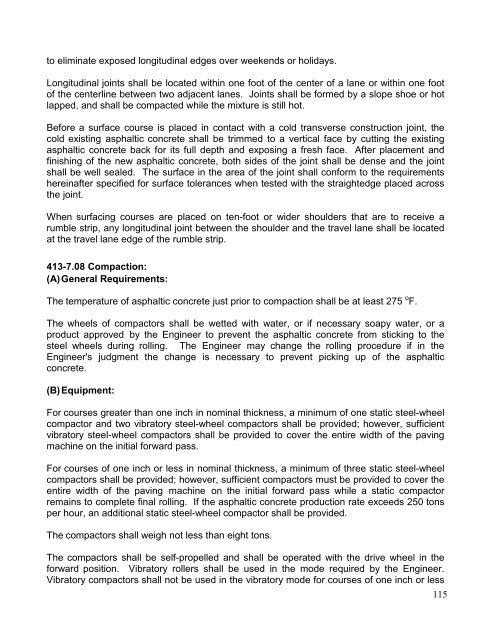Summary of Rubber Modified Asphalt Product Specifications around ...
Summary of Rubber Modified Asphalt Product Specifications around ...
Summary of Rubber Modified Asphalt Product Specifications around ...
Create successful ePaper yourself
Turn your PDF publications into a flip-book with our unique Google optimized e-Paper software.
to eliminate exposed longitudinal edges over weekends or holidays.<br />
Longitudinal joints shall be located within one foot <strong>of</strong> the center <strong>of</strong> a lane or within one foot<br />
<strong>of</strong> the centerline between two adjacent lanes. Joints shall be formed by a slope shoe or hot<br />
lapped, and shall be compacted while the mixture is still hot.<br />
Before a surface course is placed in contact with a cold transverse construction joint, the<br />
cold existing asphaltic concrete shall be trimmed to a vertical face by cutting the existing<br />
asphaltic concrete back for its full depth and exposing a fresh face. After placement and<br />
finishing <strong>of</strong> the new asphaltic concrete, both sides <strong>of</strong> the joint shall be dense and the joint<br />
shall be well sealed. The surface in the area <strong>of</strong> the joint shall conform to the requirements<br />
hereinafter specified for surface tolerances when tested with the straightedge placed across<br />
the joint.<br />
When surfacing courses are placed on ten-foot or wider shoulders that are to receive a<br />
rumble strip, any longitudinal joint between the shoulder and the travel lane shall be located<br />
at the travel lane edge <strong>of</strong> the rumble strip.<br />
413-7.08 Compaction:<br />
(A) General Requirements:<br />
The temperature <strong>of</strong> asphaltic concrete just prior to compaction shall be at least 275 o F.<br />
The wheels <strong>of</strong> compactors shall be wetted with water, or if necessary soapy water, or a<br />
product approved by the Engineer to prevent the asphaltic concrete from sticking to the<br />
steel wheels during rolling. The Engineer may change the rolling procedure if in the<br />
Engineer's judgment the change is necessary to prevent picking up <strong>of</strong> the asphaltic<br />
concrete.<br />
(B) Equipment:<br />
For courses greater than one inch in nominal thickness, a minimum <strong>of</strong> one static steel-wheel<br />
compactor and two vibratory steel-wheel compactors shall be provided; however, sufficient<br />
vibratory steel-wheel compactors shall be provided to cover the entire width <strong>of</strong> the paving<br />
machine on the initial forward pass.<br />
For courses <strong>of</strong> one inch or less in nominal thickness, a minimum <strong>of</strong> three static steel-wheel<br />
compactors shall be provided; however, sufficient compactors must be provided to cover the<br />
entire width <strong>of</strong> the paving machine on the initial forward pass while a static compactor<br />
remains to complete final rolling. If the asphaltic concrete production rate exceeds 250 tons<br />
per hour, an additional static steel-wheel compactor shall be provided.<br />
The compactors shall weigh not less than eight tons.<br />
The compactors shall be self-propelled and shall be operated with the drive wheel in the<br />
forward position. Vibratory rollers shall be used in the mode required by the Engineer.<br />
Vibratory compactors shall not be used in the vibratory mode for courses <strong>of</strong> one inch or less<br />
115


